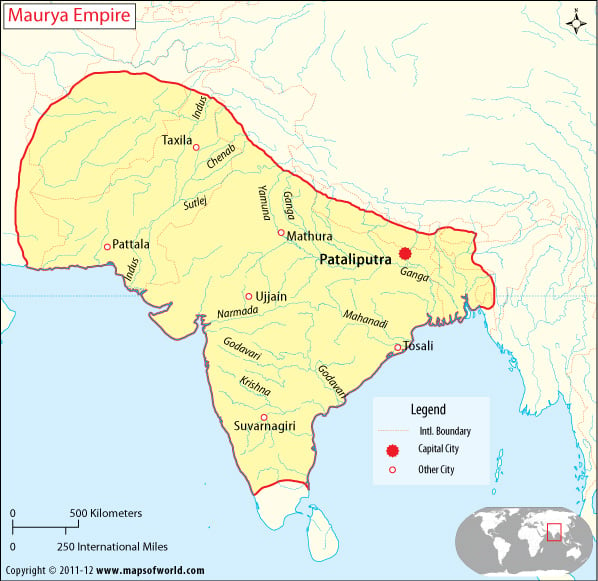The Empire of the Mauryas was founded in 322 BC by King Chandragupta Maurya, who initially conquered Magadha by dethroning the Nanda ruler, Dhana Nanda. He then invaded and annexed most of Central India and Western India. With the fall of Alexander the Great’s Empire, the local rulers could offer Chandragupta Maurya little resistance.
Chandragupta’s son Bindusara and grandson Ashoka continued the policy of imperial expansion until the Mauryan Empire covered over three million square miles. All the land between eastern Iran and the Himalayan state of Assam was under Mauryan dominion. North to south, the kingdom stretched from beyond Kashmir to parts of Tamil Nadu – one of the mightiest empires of the time.
Emperor Ashoka – Warrior or Monk?
Emperor Ashoka, later known as Ashoka the Great, reigned over the Mauryan Empire from 269 BC to 232 BC. Ashoka was initially a ruthless warrior and gifted strategist. His mercilessness earned him the epithet Chand Ashoka, meaning Ashoka the Torturous. Having amassed a highly skilled army led by elephants, Ashoka crushed the rebellions of Taxila and Ujjain. He led military expeditions to the east, furthering the boundaries of his empire into Assam and Burma.
The land of Kalinga in modern Orissa had traditionally resisted Mauryan dominion. Having built his empire all around Kalinga, Ashoka led an attack against the province itself. The kingdom resisted bravely with women, children, and common men fighting alongside the army. Ashoka’s army ravaged the land and utterly destroyed the kingdom. As Ashoka surveyed the kingdom after the battle, he was struck by terrible remorse at the destruction he had caused. He converted to Buddhism and adopted nonviolence.
When Ashoka returned to his capital at Pataliputra, he was a changed man. It is believed that he gave away his wealth to the poor and led an ascetic lifestyle. Ashoka constructed various Buddhist monasteries and stupas, or shrines, all over his kingdom, and sent emissaries to spread Buddhism to other parts of the world.
Trivia: Ashoka’s royal emblem, the four lions and the chakra (Sanskrit for wheel), has been adopted in a slightly modified form as the National Emblem of India.
Mauryan Administration – Arthashastra
The most remarkable feature of the Mauryan Empire was its superior administration. Chandragupta Maurya’s aide and adviser, Chanakya, was known to be a strategist and excellent statesman. His treatise on administration, the Arthashastra, is still considered a guide for statesmen and rulers. The Mauryan kings were excellent administrators. They commissioned the building of palaces, parks, granaries, and bridges, generating many employment opportunities in all parts of their kingdom.
Diplomatic and cordial relations were maintained with Greece, China, Sri Lanka, Burma, and many other countries. Emperor Ashoka’s daughter, Sanghamitra, was sent as a diplomatic and religious envoy to Sri Lanka. Trade and commerce received much attention from the kings. Agriculture was promoted by digging canals and facilitating irrigation. Law was fair and equitable, and taxes were low. The ability to sustain the vast empire was partly due to the efficient administration of the Mauryan kings.
Education and Culture in the Mauryan Empire
The Mauryan kings were great patrons of the arts and literature. Intellectuals such as Chanakya received the continued support of the kings. Ashoka did much for the cause of Buddhist literature in his empire. The universities of Nalanda and Taxila were set up by the Mauryans. Fine arts were cultivated and encouraged. Mauryan architecture is a standing testimony to the exemplary work done in this period. The stupas at Sanchi and Sarnath are among the best Buddhist architectural marvels of the world.
The fall of the Mauryan Empire after Ashoka may be attributed to the vastness of the empire and the lack of capable heirs. Ashoka’s policy of making Buddhism the state religion is also cited as one of the reasons. With the majority of the populace being Hindus, the proclamation is certain to have ruffled feathers. The vast cultural differences among the regions of the empire also seem to have contributed to its downfall. Whatever the reason, the end of Mauryan rule in India saw the decline of one of the most glorious empires of the subcontinent.

 Ancient Japan History
Ancient Japan History